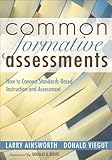Common formative assessments : how to connect standards-based instruction and assessment / Larry Ainsworth, Donald Viegut ; foreword by Douglas B. Reeves. [print]
Material type: TextPublication details: Thousand Oaks, California : Corwin Press, (c)2006.Description: xviii, 164 pages : illustrations ; 26 cmContent type:
TextPublication details: Thousand Oaks, California : Corwin Press, (c)2006.Description: xviii, 164 pages : illustrations ; 26 cmContent type: - text
- unmediated
- volume
- 9781412915779
- 9781412915786
- LB3060.V656.C666 2006
- COPYRIGHT NOT covered - Click this link to request copyright permission:
| Item type | Current library | Collection | Call number | Status | Date due | Barcode | |
|---|---|---|---|---|---|---|---|
 Circulating Book (checkout times vary with patron status)
Circulating Book (checkout times vary with patron status)
|
G. Allen Fleece Library CIRCULATING COLLECTION | Non-fiction | LB3060.83 .A37 2006 (Browse shelf(Opens below)) | Available | 31923001339213 |
Foreword Douglas B. Reeves -- Preface -- Acknowledgments -- About the authors -- Introduction -- big picture : how powerful practices connect -- parts of the whole -- circle graphic -- Begin with power standards -- Begin with data -- Begin with "unwrapping" the standards -- standards-assessment alignment diagram -- Predictive value -- value of compete alignment -- Formative and summative assessments -- purposes of assessment -- Formative and summative assessments defined -- Changing the traditional instruction-assessment cycle -- Assessment of learning -- Assessment for learning -- Is this assessment formative or summative? -- Aligning formative and summative assessments -- Teaching to the test? -- Aligning common formative assessments to standards -- Why power standards? -- Statistical rationale for identifying power standards -- Coverage vs. depth -- Prioritization, not elimination -- Which to "power" : standards, benchmarks, or indicators -- Special educators, second language educators, and special area educators -- Interdisciplinary power standards -- Aligning power standards, common formative assessments, and common summative assessments -- Aligning instruction and assessment to power standards -- Collaborative common assessment planning -- Frequency of common power standards assessments --
Connecting "unwrapped" standards to common formative assessments -- Step 1 : "Unwrap" the power standards -- Step 2 : Create a graphic organizer -- Step 3 : Determine the big ideas -- Step 4 : Write essential questions -- From "unwrapped" standards : foundation for instructional design -- Classroom performance assessments -- From classroom performance assessments to common formative post-assessments -- Assessment literacy -- need for assessment literacy -- variety of assessment types -- Major types of assessment -- major types of assessment defined -- Applying assessment literacy to individual classroom assessment -- Applying assessment literacy to common formative assessment -- Fairness, reliability, and validity -- Changing conventional assessment practice -- Developing and refining common formative assessments -- Focusing on process, not results -- Improving the quality of common formative assessments -- Deliberate delay of professional development -- Write first, refine later -- Assessment design cycle -- Creating a safe and supportive environment -- Aligning common formative assessments to power standards -- Activity 1 : Check for alignment and frequency -- Activity 2 : Identify assessment types -- Activity 3 : Evaluate assessments by established criteria -- Activity 4 : Develop an action plan for improvements -- role of administrators --
Collaborative scoring of common formative assessments -- Creating a culture of collaboration -- Professional learning communities -- Option 1 : External scoring -- Option 2 : Independent scoring -- Option 3 : Collaborative scoring -- Preparing to score constructed-response assessments -- Designing a collaborative scoring guide -- Teacher-designed, student-revised scoring guides -- Peer- and self-assessment by students -- Steps in the collaborative scoring process -- Implications for grading -- Collective wisdom -- Ready for the data team process -- Collaborative analysis of common formative assessment results -- Data rich, information poor -- Benefits of systematic data analysis -- Background of data-driven decision-making model -- Data team process overview -- Step 1 : Charting the data -- Step 2 : Analyzing strengths and challenges -- Step 3 : Setting team goal -- Step 4 : Selecting instructional strategies -- Step 5 : Determining the results indicators -- Implications for intervention and acceleration -- action plan -- post-assessment data team meeting -- Meeting, not meeting goals -- Teacher reflections --
Schoolwide and districtwide implementation of common formative assessments -- Creating the conditions -- "Whole to part" understanding -- High expectations with accompanying support -- High support strategies -- Sustained professional development -- Holding to intention in spite of hurdles -- Challenges to finding time -- Key strategies for creating time -- Collaborative leadership -- Leaders must foster trust -- Do it right the first time -- Implementation framework for planning -- Guidelines for systemwide sustainability -- Establish a culture of improvement -- Self-reflection questions for leaders -- Sage advice -- Sustained focus -- Choose your moment -- Relationships -- Sustainability -- Structures for sustainability -- Influencing the external culture -- Associating with the best -- PreK-18 collaboration -- Conclusion -- Resource : A framework for implementing powerful practices -- Bibliography -- Index.
COPYRIGHT NOT covered - Click this link to request copyright permission:
There are no comments on this title.
